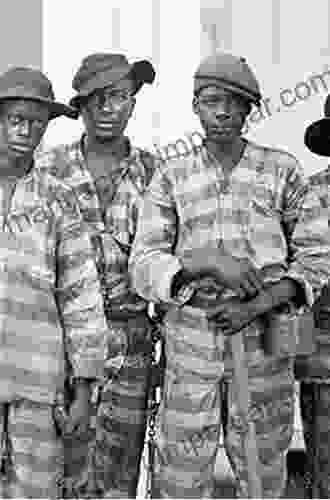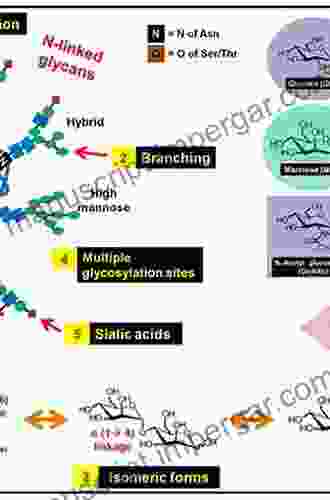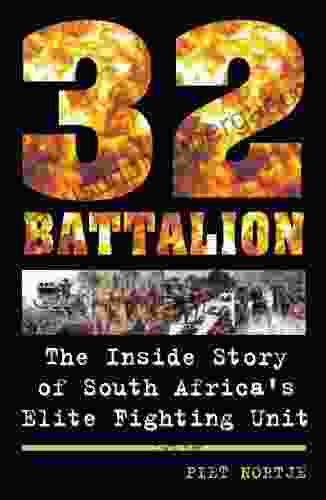Mass Spectrometry Techniques for Structural Characterization of Glycans: A Comprehensive Guide

Glycans are complex carbohydrates that play crucial roles in a wide range of biological processes, including cell-cell recognition, immune responses, and signal transduction. Due to their structural diversity and complexity, mass spectrometry (MS) has emerged as a powerful tool for the structural characterization of glycans.
5 out of 5
| Language | : | English |
| File size | : | 8261 KB |
| Text-to-Speech | : | Enabled |
| Screen Reader | : | Supported |
| Enhanced typesetting | : | Enabled |
| Print length | : | 79 pages |
| X-Ray for textbooks | : | Enabled |
Ionization Techniques
The first step in MS analysis is ionization, which converts analytes into charged particles that can be detected by the mass spectrometer. Common ionization techniques used for glycan analysis include:
- Electrospray ionization (ESI): ESI gently vaporizes and charges analytes, producing multiply charged ions that are well-suited for MS analysis.
- Matrix-assisted laser desorption ionization (MALDI): MALDI uses a matrix to absorb laser energy and facilitate the desorption and ionization of analytes.
- Atmospheric pressure chemical ionization (APCI): APCI ionizes analytes through gas-phase reactions, producing protonated or deprotonated ions.
Fragmentation Techniques
Once ions are formed, fragmentation techniques are used to break them into smaller fragments that provide structural information. Common fragmentation techniques for glycan analysis include:
- Collision-induced dissociation (CID): CID fragments ions by colliding them with an inert gas, producing fragments that reflect the glycosidic linkages and monosaccharide composition.
- Electron-transfer dissociation (ETD): ETD transfers electrons to ions, causing the formation of c- and z-type fragment ions that provide complementary structural information to CID.
- Higher-energy collisional dissociation (HCD): HCD fragments ions with higher collision energies than CID, producing more extensive fragmentation and enhanced structural coverage.
Data Analysis Approaches
The complex mass spectra generated from glycan analysis require specialized data analysis approaches to extract meaningful structural information. Common data analysis approaches include:
- GlycanBuilder: GlycanBuilder is a software tool that assists in the annotation and interpretation of glycan mass spectra, facilitating the identification of glycan structures.
- Exoglycosidase sequencing: Exoglycosidase sequencing involves the sequential removal of monosaccharides from the non-reducing terminus of a glycan using specific enzymes, allowing for the stepwise determination of the glycan structure.
- Database searching: Database searching algorithms compare experimental mass spectra to libraries of known glycan structures, enabling the identification of known glycans or the discovery of novel structures.
Applications
Mass spectrometry techniques for structural characterization of glycans have wide-ranging applications in various fields, including:
- Glycobiology: MS analysis is used to study the structure and function of glycans involved in biological processes.
- Pharmaceutical development: MS is employed to characterize the glycosylation of therapeutic proteins, ensuring their efficacy and safety.
- Biomarker discovery: Glycan profiling using MS can identify potential biomarkers for diseases such as cancer and neurodegenerative disFree Downloads.
Mass spectrometry techniques provide a powerful platform for the structural characterization of glycans. The combination of ionization, fragmentation, and data analysis approaches enables the elucidation of complex glycan structures with high accuracy and sensitivity. These techniques have revolutionized the field of glycomics and continue to contribute to our understanding of the role of glycans in biological systems.
5 out of 5
| Language | : | English |
| File size | : | 8261 KB |
| Text-to-Speech | : | Enabled |
| Screen Reader | : | Supported |
| Enhanced typesetting | : | Enabled |
| Print length | : | 79 pages |
| X-Ray for textbooks | : | Enabled |
Do you want to contribute by writing guest posts on this blog?
Please contact us and send us a resume of previous articles that you have written.
 Book
Book Novel
Novel Page
Page Chapter
Chapter Text
Text Story
Story Genre
Genre Reader
Reader Library
Library Paperback
Paperback E-book
E-book Magazine
Magazine Newspaper
Newspaper Paragraph
Paragraph Sentence
Sentence Bookmark
Bookmark Shelf
Shelf Glossary
Glossary Bibliography
Bibliography Foreword
Foreword Preface
Preface Synopsis
Synopsis Annotation
Annotation Footnote
Footnote Manuscript
Manuscript Scroll
Scroll Codex
Codex Tome
Tome Bestseller
Bestseller Classics
Classics Library card
Library card Narrative
Narrative Biography
Biography Autobiography
Autobiography Memoir
Memoir Reference
Reference Encyclopedia
Encyclopedia Charles Kovacs
Charles Kovacs Christopher Easton
Christopher Easton Margaret Killjoy
Margaret Killjoy Richard Raffan
Richard Raffan Megan Fox
Megan Fox Cheryl Fuller
Cheryl Fuller Christy Wright
Christy Wright Danny Bernstein
Danny Bernstein Christopher I Beckwith
Christopher I Beckwith Christopher Reed
Christopher Reed Joseph Devlin
Joseph Devlin Riki Therivel
Riki Therivel Richard Irvin
Richard Irvin Josh Fruhlinger
Josh Fruhlinger David Holub
David Holub Wolfgang Daunicht
Wolfgang Daunicht Chris Hansen
Chris Hansen Chris Whipple
Chris Whipple Christine Perry
Christine Perry Christopher Townley
Christopher Townley
Light bulbAdvertise smarter! Our strategic ad space ensures maximum exposure. Reserve your spot today!
 Stephen KingFollow ·6.2k
Stephen KingFollow ·6.2k Lucas ReedFollow ·3.6k
Lucas ReedFollow ·3.6k Osamu DazaiFollow ·13.2k
Osamu DazaiFollow ·13.2k Isaiah PriceFollow ·6.2k
Isaiah PriceFollow ·6.2k Carlos FuentesFollow ·15.6k
Carlos FuentesFollow ·15.6k Dan HendersonFollow ·19.7k
Dan HendersonFollow ·19.7k Duncan CoxFollow ·11.5k
Duncan CoxFollow ·11.5k Jedidiah HayesFollow ·8.9k
Jedidiah HayesFollow ·8.9k

 E.E. Cummings
E.E. CummingsOne Man's Story of What It Meant to be Pj
In the tapestry of life,...

 Caleb Long
Caleb LongPattern Theory in Video Keno: Unveiling the Art of...
Embark on an enlightening journey into the...

 Douglas Adams
Douglas AdamsUnveiling the Diplomatic Landscape: The Ottoman Empire,...
Delving into the History...

 Terry Bell
Terry BellThere Still Is No Off Season: Embracing Year-Round...
In a world consumed by routine and the allure...

 Ibrahim Blair
Ibrahim BlairBrain Teasers Games and Puzzles: Exercise Your Mind with...
Prepare to embark on a captivating journey...
5 out of 5
| Language | : | English |
| File size | : | 8261 KB |
| Text-to-Speech | : | Enabled |
| Screen Reader | : | Supported |
| Enhanced typesetting | : | Enabled |
| Print length | : | 79 pages |
| X-Ray for textbooks | : | Enabled |














